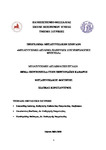| dc.creator | Roumeliotis A., Roumeliotis S., Leivaditis K., Salmas M., Eleftheriadis T., Liakopoulos V. | en |
| dc.date.accessioned | 2023-01-31T09:51:56Z | |
| dc.date.available | 2023-01-31T09:51:56Z | |
| dc.date.issued | 2021 | |
| dc.identifier | 10.1007/s11255-020-02678-6 | |
| dc.identifier.issn | 03011623 | |
| dc.identifier.uri | http://hdl.handle.net/11615/78571 | |
| dc.description.abstract | The use of Automated Peritoneal Dialysis (APD) in its various forms has increased over the past few years mainly in developed countries. This could be attributed to improved cycler design, apparent lifestyle benefits and the ability to achieve adequacy and ultrafiltration targets. However, the dilemma of choosing the superior modality between APD and Continuous Ambulatory Peritoneal Dialysis (CAPD) has not yet been resolved. When it comes to fast transporters and assisted PD, APD is certainly considered the most suitable Peritoneal Dialysis (PD) modality. Improved patients’ compliance, lower intraperitoneal pressure and possibly lower incidence of peritonitis have been also associated with APD. However, concerns regarding increased cost, a more rapid decline in residual renal function, inadequate sodium removal and disturbed sleep are APD’s setbacks. Besides APD superiority over CAPD in fast transporters, the other medical advantages of APD still remain controversial. In any case, APD should be readily available for all patients starting PD and the most important indication for its implementation remains patient’s choice. © 2020, Springer Nature B.V. | en |
| dc.language.iso | en | en |
| dc.source | International Urology and Nephrology | en |
| dc.source.uri | https://www.scopus.com/inward/record.uri?eid=2-s2.0-85092466971&doi=10.1007%2fs11255-020-02678-6&partnerID=40&md5=8799d14466fe40e85af075ee7e71cb7d | |
| dc.subject | glucose | en |
| dc.subject | automated peritoneal dialysis | en |
| dc.subject | blood pressure | en |
| dc.subject | continuous ambulatory peritoneal dialysis | en |
| dc.subject | coronavirus disease 2019 | en |
| dc.subject | employment | en |
| dc.subject | end stage renal disease | en |
| dc.subject | financial management | en |
| dc.subject | glucose blood level | en |
| dc.subject | health care cost | en |
| dc.subject | heart left ventricle hypertrophy | en |
| dc.subject | human | en |
| dc.subject | incidence | en |
| dc.subject | kidney function | en |
| dc.subject | lifestyle modification | en |
| dc.subject | natural disaster | en |
| dc.subject | pandemic | en |
| dc.subject | patient compliance | en |
| dc.subject | patient preference | en |
| dc.subject | peritoneal dialysis | en |
| dc.subject | peritonitis | en |
| dc.subject | quality of life | en |
| dc.subject | Review | en |
| dc.subject | sleep disorder | en |
| dc.subject | survival rate | en |
| dc.subject | ultrafiltration | en |
| dc.subject | chronic kidney failure | en |
| dc.subject | continuous ambulatory peritoneal dialysis | en |
| dc.subject | patient selection | en |
| dc.subject | Humans | en |
| dc.subject | Kidney Failure, Chronic | en |
| dc.subject | Patient Selection | en |
| dc.subject | Peritoneal Dialysis | en |
| dc.subject | Peritoneal Dialysis, Continuous Ambulatory | en |
| dc.subject | Springer Science and Business Media B.V. | en |
| dc.title | APD or CAPD: one glove does not fit all | en |
| dc.type | other | en |


